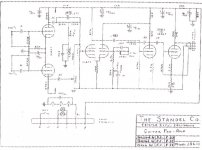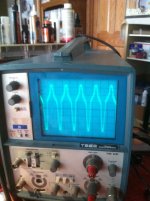Hey Fella's,
I will start off by saying that I am a huge fan of the Standel 25L15 guitar amplifier. Almost everywhere you read, you will find that everyone says that the 25L15 has amazing cleans and unbelievable headroom. I have built 3 of these amps VERY similar to the hand drawn schematic that I attached to the thread. I am having problems in all of the my amps with a static-y sounding distortion that is very unpleasant when the amp is pushed passed about 5 for the JBL D130 speaker and about 3 for another speaker I have (University 6201). I would expect the headroom to be better than this, especially passed 3 for the University speaker!
Now taking a look at the schematic - the preamp design is VERY unique for a guitar amplifier. The 12AT7 tube is where I suspect problems. The first triode of the 12AT7 is the second gain stage and that outputs to the grid of the 12AU7 first triode. Off the plate of the first triode signal goes up through the bass and treble controls and back to the 12AT7 second triode - which is setup as a cathode follower. The cathodes of the 12AT7 are connected so the signal from the cathode follower is injected back to the cathode of the first triode - essentially negative feedback over 2 stages.
From a performance standpoint, the 12AT7 can be a very squirrly tube - it is susceptible to being very microphonic and also subject to strange oscillations. Some tubes work in it and other don't. It is definitely not setup like most cathode followers in guitar amps. I find it strange that both triodes are biased from the same cathode resistor when one side of the plate receives full B+ and the B+ of the other triode is dropped over a 47K plate resistor. Is this really an issue?
I have looked at the plate at the 12AT7 first triode with a scope and found a strange behavior ( I haven't seen it before, I hope some of you have). I have attached a picture of this behavior. Once the volume knob is rotated past about 3, these sharp peaks occur. They get very steep and then eventually get cut off. Does anyone know what is going on here? Is it because of the negative feedback?
Well I could go on forever, but I think I will leave it at this. I am relatively new to tube amp circuits - so if I am missing something obvious - I apologize. If anyone could offer any insight into what is going on with the 12AT7 from a design point of view - that would be wonderful and very helpful! Also if anyone knows of any other references that discuss tone controls over negative feedback with 2 stages (OTHER than Langford-smith page 646). Thanks everyone!
I will start off by saying that I am a huge fan of the Standel 25L15 guitar amplifier. Almost everywhere you read, you will find that everyone says that the 25L15 has amazing cleans and unbelievable headroom. I have built 3 of these amps VERY similar to the hand drawn schematic that I attached to the thread. I am having problems in all of the my amps with a static-y sounding distortion that is very unpleasant when the amp is pushed passed about 5 for the JBL D130 speaker and about 3 for another speaker I have (University 6201). I would expect the headroom to be better than this, especially passed 3 for the University speaker!
Now taking a look at the schematic - the preamp design is VERY unique for a guitar amplifier. The 12AT7 tube is where I suspect problems. The first triode of the 12AT7 is the second gain stage and that outputs to the grid of the 12AU7 first triode. Off the plate of the first triode signal goes up through the bass and treble controls and back to the 12AT7 second triode - which is setup as a cathode follower. The cathodes of the 12AT7 are connected so the signal from the cathode follower is injected back to the cathode of the first triode - essentially negative feedback over 2 stages.
From a performance standpoint, the 12AT7 can be a very squirrly tube - it is susceptible to being very microphonic and also subject to strange oscillations. Some tubes work in it and other don't. It is definitely not setup like most cathode followers in guitar amps. I find it strange that both triodes are biased from the same cathode resistor when one side of the plate receives full B+ and the B+ of the other triode is dropped over a 47K plate resistor. Is this really an issue?
I have looked at the plate at the 12AT7 first triode with a scope and found a strange behavior ( I haven't seen it before, I hope some of you have). I have attached a picture of this behavior. Once the volume knob is rotated past about 3, these sharp peaks occur. They get very steep and then eventually get cut off. Does anyone know what is going on here? Is it because of the negative feedback?
Well I could go on forever, but I think I will leave it at this. I am relatively new to tube amp circuits - so if I am missing something obvious - I apologize. If anyone could offer any insight into what is going on with the 12AT7 from a design point of view - that would be wonderful and very helpful! Also if anyone knows of any other references that discuss tone controls over negative feedback with 2 stages (OTHER than Langford-smith page 646). Thanks everyone!
Attachments
You should have this moved to the "Instruments and Amps" section of the forum. Contact one of the admins. Other than that, the schematic is difficult to read, but I don't see grid stop resistors being used. Have you tried that?
Last edited:
Thanks for moving it to the right forum. Not quite sure how I missed that section. Oh well.
Yes I have added grid stoppers - small ones, 22K. The amp has a cathodyne phase inverter. Based on Merlin's recommendations, I put large grid stoppers on the 807's (120K's).
It was very strange - I brought the amp over to a friends house tonight and we played through it and we had a hard time to make it break up. I am now wondering if something on my workbench was causing some sort of oscillation. I will have to do some checking tomorrow. Thanks!
Yes I have added grid stoppers - small ones, 22K. The amp has a cathodyne phase inverter. Based on Merlin's recommendations, I put large grid stoppers on the 807's (120K's).
It was very strange - I brought the amp over to a friends house tonight and we played through it and we had a hard time to make it break up. I am now wondering if something on my workbench was causing some sort of oscillation. I will have to do some checking tomorrow. Thanks!
- Status
- Not open for further replies.


 Moved to I & A per forum policy.
Moved to I & A per forum policy.